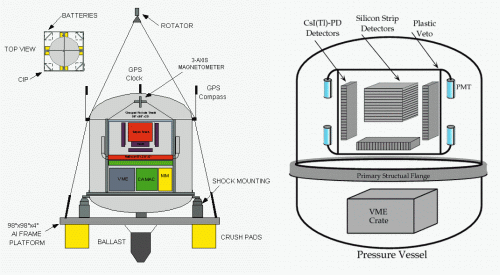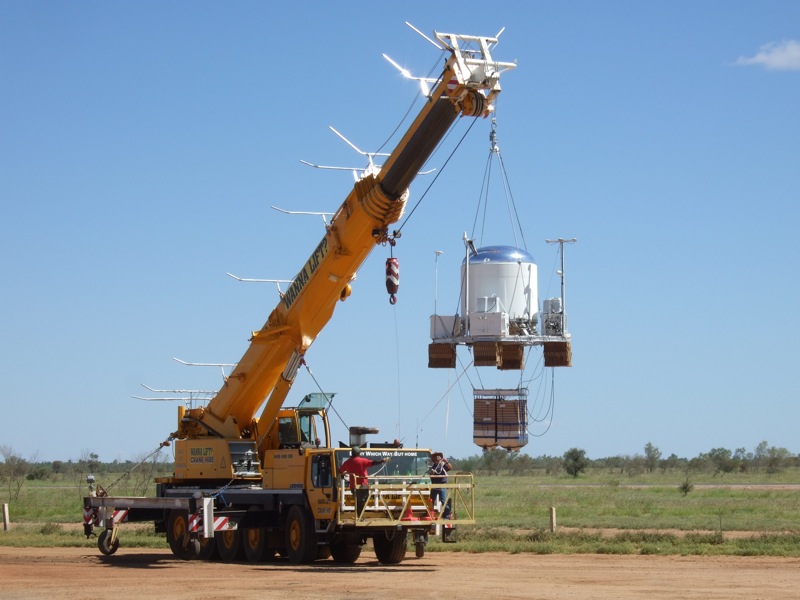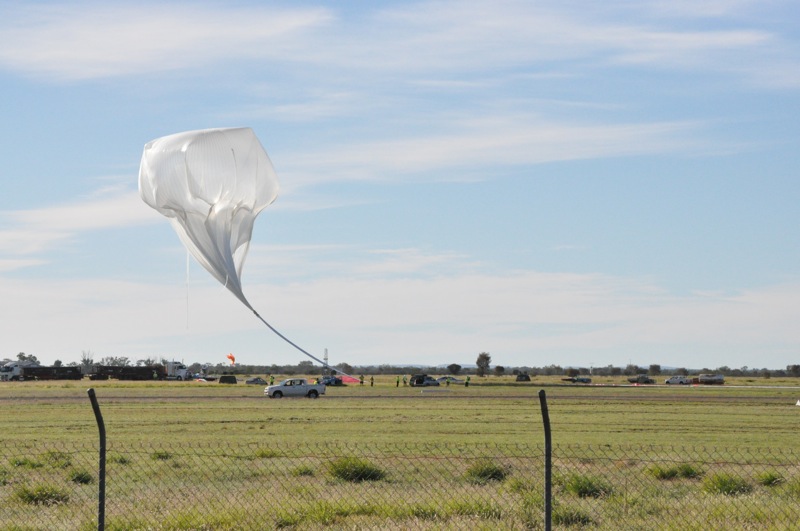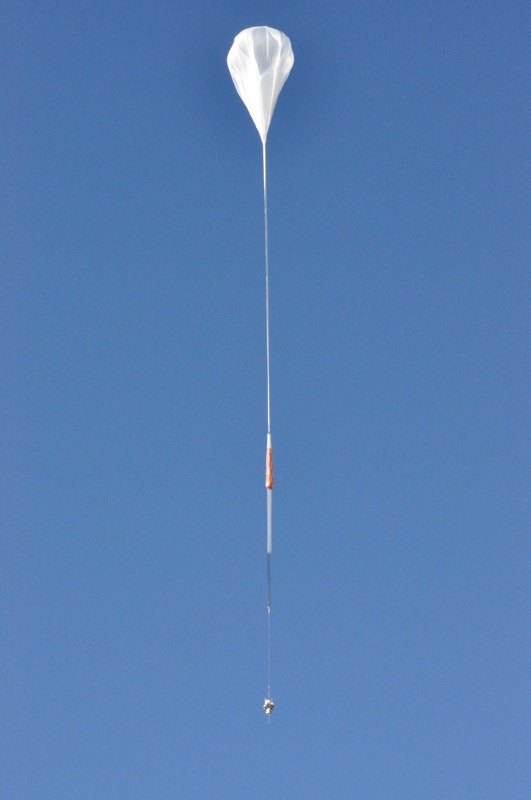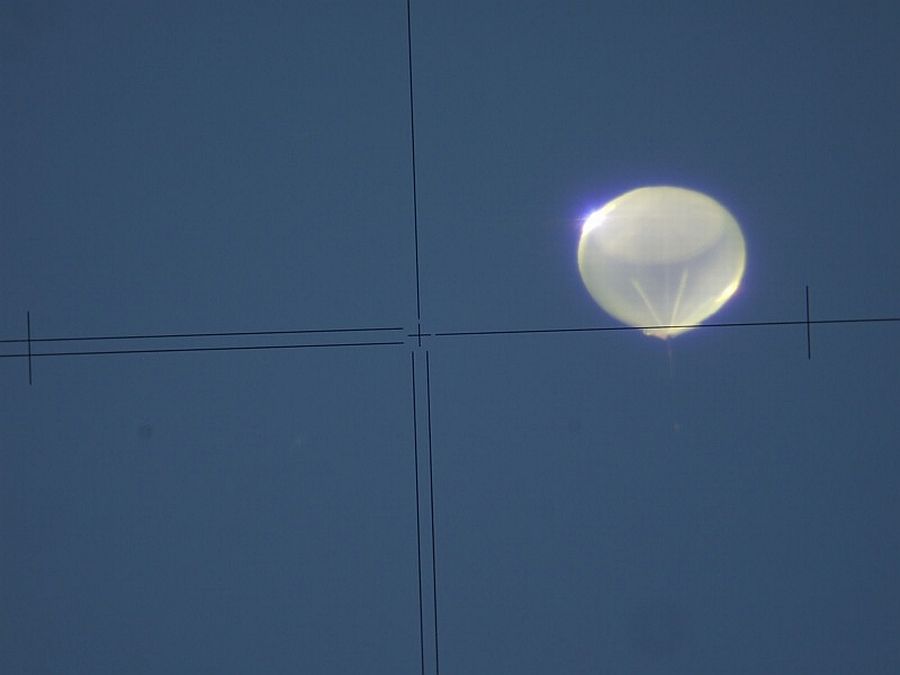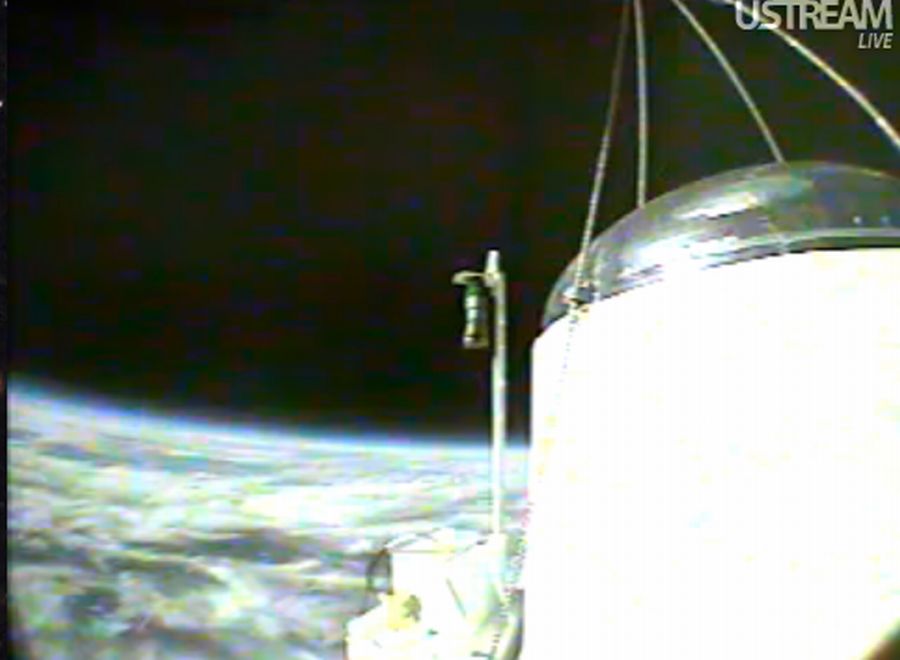Purpose of the flight and payload description
This instrument is a balloon-borne telescope of a new kind for making gamma-ray observations in the MeV energy range. It uses multi-layers of thin silicon detectors to track and measure the energy losses of Compton recoil electrons. When combined with the direction and energy of the Compton scattered gamma ray a unique incident direction for each photon event is determined. This facilitates background rejection, improved sensitivity, and image reconstruction.
At left we can see an scheme of his configuration (click to enlarge).
Basically is composed by two major elements. The first, called D1, consists of 50 or more layers of double sided silicon strip detectors (SSDs). These detect charged particles passing through the detector, giving X and Y coordinates of the interaction location with a resolution of less 1 mm. The second component, D2, consists of 5 to 10 layers of cadmium zinc telluride (CZT) strip detectors. The CZT is arranged to form a five-sided box surrounding D1. This design feature is new for Compton telescopes, and allows TIGRE to detect large angle Compton scatter events. This capability greatly enhances the instrument's efficiency, as well as providing the ability to perform as a gamma-ray polarimeter.
Ideally, an incoming gamma ray Compton scatters in the top layer (D1), with the energy of the recoil electron being measured there. The gamma ray is then absorbed in the bottom layer (D2). The Compton scatter formula can then be used to calculate the scatter angle of the gamma ray. The locations of the interactions in D1 and D2 are found by timing and pulse height analysis, and can be used to give the direction of the scattered photon. The time of flight of the photon from D1 to D2 can also be measured to discriminate downward from upward (background) events.
Another feature of TIGRE is that it was also designed to overcome many of the common limitations of Compton telescopes. First and foremost, the use of SSDs gives the potential to track the Compton recoil electron. With the knowledge of the scattered electron's energy and direction, the possible directions of the incident gamma ray describe a small arc on the sky, rather than a complete ring, greatly reducing potential source confusion and increasing sensitivity. The electron tracking also allows kinematic rejection of various backgrounds, such as events which first interact in D2, as well as events which are not completely absorbed by the detector. This background rejection capability leads to enhanced sensitivity and resolving power. A second significant advance in the design of TIGRE is the use of the CZT strip detectors. The fine pitch (< 1 mm) of the CZT strip detectors allows high spatial resolution to be attained without a large (> 1 m) separation between D1 and D2. This not only results in a more compact instrument, but also allows to extend D2 up the sides of the detector, to form a sort of open-ended box surrounding D1. Such a configuration allows for many more coincidences between D1 and D2, improving efficiency in the Compton regime by a factor of 5 or 10 over previous Compton telescope designs. In addition, surrounding D1 in this way allows events with large scatter angles to be detected, transforming TIGRE in a highly effective gamma ray polarimeter.
TIGRE will also act as a low energy pair detector in the energy range 10-100 MeV as the SSDs will serve both as converter and tracker, while the CZT arrays will act as the calorimeter. The relatively low density of silicon allows the propagation of low energy pairs through several layers of the detector. The fact that TIGRE is at the same time both a Compton telescope and a pair detector, gives the instrument a relatively constant efficiency of about 10% over the entire energy range 0.3-100 MeV. Combining this with a wide field of view (+/- 60 degrees) and the background rejection capability afforded by electron tracking, TIGRE is well-suited for a variety of gamma-ray astronomical observations.
The energy range 0.3-100 MeV is important because it contains the critical signatures of a variety of emission processes, including electron bremsstrahlung, cosmic-ray/matter interactions, and inverse Compton processes. A proper evaluation of the gamma-ray spectral shape in this range is necessary for the study of the physical mechanisms generating the gamma rays. Further, enhanced angular resolution and sensitivity will likely lead to discovery of new types of gamma-ray sources and provide more detailed information about the nature of diffuse gamma-ray emission in our galaxy.
Also as a piggyback payload was included onboard the TIGRE gondola, a cassette of uncured composite materials with epoxy resin matrixes that were exposed in the stratosphere over the three days of the flight. The goal of the experiment was an investigation of the effect of the stratospheric conditions on the uncured polymer matrix of the composite material. The experiment was part of a cooperation between the Nasa Balloon Program and the University of Sidney.
Video of the launch operations
Details of the balloon flight
Balloon launched on: 4/16/2010
Launch site: Australian Balloon Launching Station, Alice Springs, Australia
Balloon launched by: Columbia Scientific Balloon Facility (CSBF)
Balloon manufacturer/size/composition: Zero Pressure Balloon
Flight identification number: 611N
End of flight (L for landing time, W for last contact, otherwise termination time): 4/18/2010
Balloon flight duration (F: time at float only, otherwise total flight time in d:days / h:hours or m:minutes - ): 57 h
Landing site: 70 km SW of Longreach, Australia
The balloon was launched by dynamic method using a crane as launch vehicle on Friday morning, 16 April. After an initial climb phase the balloon reached float altitude flawlessly.
As the stratospheric winds were slow moving, they had the balloon hovering in the neighbourhood of Alice Springs for a while before a progressive northeast-ward path was achieved.
After 57 hours of flight it was terminated near Longreach, Queensland on Sunday evening, 18 April.
A Recovery Crew departed from Alice Springs on Saturday morning, arriving Longreach on Monday. The payload recovery was the next day afternoon. After being picked up from a farm located 70 km south of the city, the TIGRE payload was left in storage in a hangar at the Longreach Airport to be transported later at the end of the campaign back to Alice Springs.
During this first flight on the southern hemisphere TIGRE collected data at an altitude of 130,000 feet for approximately 52 hours.
The primary targets were Sagitarius A+ (the black hole at the galactic center) and various pulsars visible from the southern hemisphere in the galactic neighborhood.
The telescope performed very well and was turned off after all batteries were depleted. After landing, a team of the TIGRE group was dispatched to the site where the telescope touched ground to recover it and remove the sensitive data from the machine. Analysis of the data is in progress.
External references
- TELIS website University of California - Riverside (via Archive.Org - original website no longer available)
- Allen D. Zych website at University of California server
- Balloon science ABC interview with Prof. Ravi Sood
- Composite materials with uncured epoxy matrix exposed in stratosphere during NASA stratospheric balloon flight Report on polymerisation in stratosphere during stratospheric balloon flight from Alice Springs, Australia, 16-18 April, 2010. NASA mission
- Compton Recoil Electron Tracking With the TIGRE Gamma-Ray Balloon Experiment Ph.D Thesis by Kaoru Kamiya, University of California, Riverside, 2011
- Giant NASA balloon lands in outback ABC news item
- Space balloon takes off ABC news item
6219If you consider this website interesting or useful, you can help me to keep it up and running with a small donation to cover the operational costs. Just the equivalent of the price of a cup of coffee helps a lot.

